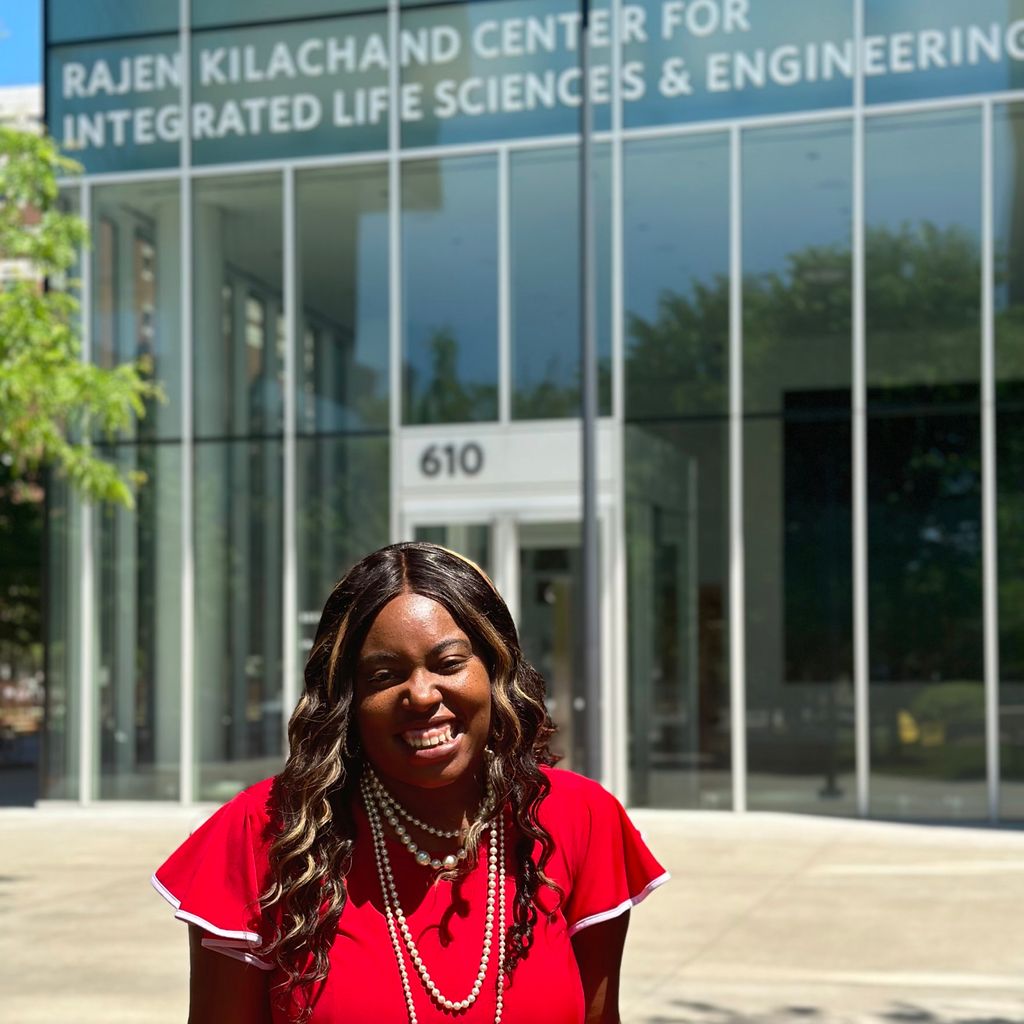BU Scientists Engage High School Students for Hands-On STEM Experience
The outreach program STEM Pathways aims to establish a STEM pipeline by exposing college undergraduates and greater Boston-area high school students to synthetic biology, computational biology, and biotechnology via a range of programming that includes lab-skills training, hackathons, industry internships, and participation in an international synthetic biology design competition. Professor Doug Densmore serves as principal investigator for the $2.3M, three-year Department of Defense STEM grant that supports this program.
Hailey Lenn Gordon, who was hired as Director of STEM Pathways in 2022, sat for an interview to share reflections on her first year at the helm.

What is the core challenge that STEM Pathways addresses?
STEM Pathways aims to overcome the inequity in STEM fields generally and in biotech fields specifically. To pursue professional opportunities in biotech, students need to develop skillsets that are often not featured as part of their basic curriculum. We level the playing field for underserved students, so they can explore an interest in areas like microfluidic technology, cell therapy, or gene editing. Students are increasingly aware of these cool engineering- and science-related things happening around them and they’re wondering how they can get involved. For instance, maybe they hear in the news about CRISPR systems that can be programmed to edit DNA at precise locations, or maybe they get curious about the Impossible Burger they just ate (because that burger was a synthetic biology product). STEM Pathways creates opportunities to get involved in these fields.
How does STEM Pathways fit within with the Biological Design Center?
The Biological Design Center (BDC) brings together graduate students, post-doctoral fellows, and faculty from multiple disciplines and departments at BU—including biomedical engineering, biology, electrical engineering, computer science, physics, and chemistry—to build a diverse, inclusive, and collaborative community that conducts groundbreaking research in biological design and sets the standards for education and training in synthetic biology and biotechnology. This makes the BDC an outstanding source of experiential learning opportunities for STEM Pathways students. And Professor Douglas Densmore, a BDC faculty member, serves as principal investigator for the grant supporting STEM Pathways.
STEM Pathways engages faculty, graduate students, undergraduates, and high school students. How does it all work?
The way STEM research laboratories generally work is that graduate students who are pursuing PhD degrees in fields like biomedical engineering and biology are conducting research as part of their thesis. They work closely with their principal investigators (the faculty) to get mentorship, but they also develop their own research questions. These graduate students, in turn, will often recruit undergraduate students to help them accomplish some of their entry-level lab tasks, so now undergraduate students are getting those basic skills that they may have previously only read about in a paper or a homework assignment. STEM Pathways can facilitate and enhance these research opportunities for undergraduates through our programming.
In the summertime, we also invite high school students to come to BU and work in the lab. Integrating high school students essentially creates two levels of mentorship, such that an undergraduate who is paired with a high school student can say “Hey, I just learned this, and now I can teach you.” They receive mentorship from graduate students too, which allows the high school students to observe and understand the educational and professional journey of a scientist—from high school to undergraduate to graduate studies—and how at each level they operate with increasing independence as a researcher.

What drew you personally to STEM Pathways?
I am an African-American woman who was fortunate enough to have family members and mentors in my life who looked like me and were in a STEM field. My aunt works at NASA, my mom’s a nurse, and my uncle is a physician assistant. It wasn’t until I got to college that I realized that wasn’t the norm. I will never forget going to my first computer science class at UC Berkeley. I was probably the only black person in the room, not to mention one of a very small number of women. As I continued to figure out my place in the academic and STEM world, I experienced some imposter syndrome, and I always thought, “I don’t want this to happen to other people,” so I mentored as a volunteer with organizations like Black Girls Code and Tech Girls.
Meanwhile, I loved the research I was doing in neural engineering, but I gradually realized that I was even happier helping other people succeed and pushing them to achieve their dreams. Running STEM Pathways helps me stay integrated in the research that’s happening at BU while also letting me mentor and connect other mentors to students who have backgrounds like mine.
Give me some examples of the STEM pathways programming.
We offer a broad range of programming for high school students. For example, there are wet-lab opportunities, where the students can develop valuable skills that may not be available to them unless they take AP Biology or if their school has a Biotechnology CTE Program. High school students can come to a BDC lab and get one-on-one mentorship with both an undergraduate student and a graduate student. They’re assigned a project and a team. They may learn to run a gel, or how to do mini prep, just the beginning steps of wet lab research. We also have smaller opportunities for students who can’t dedicate their whole summer. Our partner, the BioBuilder Educational Foundation, has created a series of fantastic, hands-on modules that we’ve turned into weekend workshops.
We also have students who are more interested in computational biology. For them, we do things like hackathons. These aren’t quite like an adult hackathon but more of a tutorial that demonstrates how coding can be used for biology and data and science. A recent one focused on the Python coding language which is super friendly for students with no prior experience. We demonstrate how a basic coding package would work if you were trying to edit a gene. The coding isn’t as complicated as they use in the real world, but it lays the foundations and gets students thinking about how valuable it is if they can learn a little bit of coding.
Besides wet-lab and computational opportunities, we also offer a free virtual course in synthetic biology—three introductory lectures where we’re giving examples about what synthetic biology is, how it’s used in the real world, or where you may have seen it before. Afterward participants can direct questions to graduate students and PIs. We try to use the virtual courses as a gateway that draws students to the more hands-on opportunities like wet labs and hackathons.
And we run mini-Jamborees, which are free, interactive days of learning and fun to increase awareness of synthetic biology and biotechnology.
STEM Pathways also supports students in a worldwide synthetic biology project competition. Can you say more about that?
Yes! The International Genetically Engineered Machine (or iGEM) Competition creates opportunities for multidisciplinary student teams to work together to design, build, test, and measure a system using interchangeable biological parts and standard molecular biology techniques. STEM Pathways is responsible for coordinating and supporting Boston University’s iGEM team which can comprise a collaboration of undergraduate students, high school students, and graduate student mentors from any fields who are interested in trying to tackle some synthetic biology problem.
The annual competition takes place in Paris, France, and that’s where we go every year to present our ideas—a good perk of being on the iGEM team! The 2022 iGEM Team received a gold medal and a nomination for the Best Environment Project. The competition is a great collaboration opportunity that can synthesize a broad range of students’ majors, ideas, and interests—for instance, you might have a student who’s interested in robotics coming up with cool hardware they want to test on a biological process.

Have you observed changes in participants’ attitudes toward STEM as a potential career path?
You can see their body language change over the course of the semester, their willingness to stand up and speak about what they’re doing. At the welcome kickoff meeting, when I tell them that they’re going to be making a final presentation at the end of the semester, most of them look at me like a deer in headlights. Undergraduates often have this sense at the beginning that they are just a worker bee, someone behind the scenes with no ownership of the research happening. But by the time they are preparing their final poster presentation, I can see how much their confidence and enthusiasm has grown.
Another marker of their confidence is in the lab skills they’ve developed. For instance, there’s a basic biotech procedure known as “running a gel,” and it’s the first task students are assigned in the lab. In the beginning of the semester I hear, “It did not work today. It didn’t work yesterday. It’s probably never going to work.” And by the end of the semester they’re saying, “Oh, we do those in our sleep now.”
Are the people providing instruction and mentorship volunteers?
Apart from myself, all STEM Pathways mentors are volunteers. My strong suits are neural engineering or computation, but for any area outside my expertise, like gene editing, I must definitely lean on grad students and PIs with experience in those areas and ask if they’d be willing to help me develop lecture modules and coding challenges. Even my undergraduate students—who often experience both sides of mentorship in STEM Pathways—volunteer at these things as Q&A discussants or teaching assistants.
What would you want to say to scientists you haven’t recruited yet about getting involved?
I think it’s a lower lift than most busy scientists are expecting. Do you have an hour to give a research talk or a Q&A session? All I need you to do is tell them about your research, and I’ll figure out the logistics. I can reserve the room, bring the students, bring the snacks. You just show up and provide your knowledge.
Does your grant have an outreach component? I’m happy to help you come up with a plan for broadening participation that complements your research and integrates well with what STEM Pathways is already doing. Maybe that means tailoring our hackathon curriculum to better reflect what you’re doing in your lab. Maybe it’s conducting a lab experiment for students that represents a base level of the work happening in your lab. It’s all about integrating the grant’s research objectives with a curriculum applicable to younger students that helps broaden the overall impact. I’ve helped lots of PIs write those types of things.
Are there opportunities for non-BDC researchers at Boston University to get involved with STEM Pathways?
The STEM Pathways grant focuses on the fields of synthetic biology and computational biology, but there are so many ways the other STEM fields can connect to those two. For instance, we’ve been able to talk about robotics through automation and automating different synthetic biology processes. We’ve been able to talk about general biology and computer engineering via the computational tools or by talking about biological circuits. I can be very creative about finding ways your research connects to synthetic biology.
*This interview was conducted and edited by Jim Cooney.

STEM Pathways Students Speak Out
Brooklynn Marcelin (high school student)
What did you work on this week?
“I worked mainly on finishing my projects and on our construct because there was a mutation we had to fix in the gene. I also got to shadow my mentor while he worked in the cell culture room which I thought was nice.”
What was your favorite part of this week?
“I really like talking to my mentor and partner when we’re working in the lab, hearing how he got to where he is and how.”
Marko Radulovic (undergraduate)
What did you work on this week?
“I did practice microinjections at the 2-cell stage with a dye and started my first attempt at our lab’s Alcian blue stain protocol.”
What major goal do you want to accomplish by end of summer?
“I want to finish the manuscript [I’m working on] for my first co-authorship.”